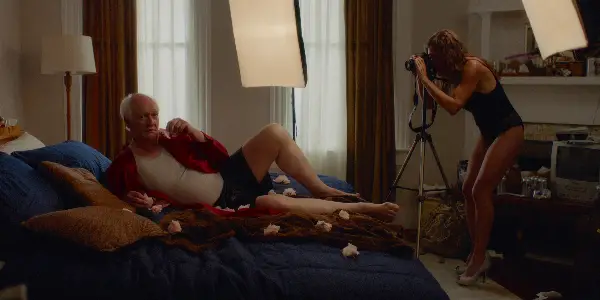
It’s that time of year again, when holiday films avalanche onto streaming services, snuggle-core TV channels, and on-demand movie services. How to Ruin the Holidays is maybe the least auspicious of the lot, but at least it has a promising cast.
Amber Nash leads the film as Michelle, an unsuccessful improv comedian struggling to make ends meet in Los Angeles. Her only ally in the rat race is her flatmate, Suzy (Aisha Tyler), who’s also gunning for the same gigs as her. Michelle is spirited away to Georgia for the holidays by her sister, Andrea (Kate Lambert), who’s trying to get their intense libertarian doomsday-prepper father (Colin Mochrie) to clean up his home and sell it. The plan is complicated by Dad, who of course doesn’t want to leave, and their developmentally disabled brother, Mark (Luke Davis), who doesn’t see the issues of living in a messy home with him.
If the premise sounds like a slightly more interesting variation on a Hallmark or Lifetime Channel original holiday movie, then you’re not far off the mark. Sometimes, the film clearly wants to be a little edgier than your average made-for-TV Christmas film, but How to Ruin the Holidays is about as edgy as a Christmas tree bauble and not nearly as shiny. I low-key really love some of the Hallmark/Lifetime Channel movies, anyway, and it brings me no pleasure to say that even the bad ones are a lot more engaging than How to Ruin the Holidays. At their worst, they’re at least good background noise to wrap presents to. How to Ruin the Holidays, however, is just noise.
Colin Mochrie, Adopt Me Please
The title is trite, the premise is basic, and the poster is, frankly, not very good either. But you know who always delivers no matter what? Colin Mochrie. A Scottish-born Canadian goose of a man, Mochrie is undoubtedly one of our greatest living comedians. He’s the poutine of comedy: amazing, wholesome, and covered in gravy at all times. Famous mostly for his touring shows where he and Brad Sherwood hit each other in the genitals with mousetraps as well as his decades-long tenure on improvisational comedy series like Whose Line Is It Anyway?, Mochrie has been inspiring comedians, redefining the art of improv, and making people laugh for longer than I’ve been alive. The mousetrap industry owes him a lot.
source: Felipe Vara de Rey/ Buffalo 8 Productions
He is completely out of place in How to Ruin the Holidays because you know he’s better than the material — and he often proves that, giving amazing readings of sub-par lines like “Taking sexy pics is like planting a tree or buying a house: best time to do it? Ten years ago. Second best time to do it? Right now. Ten a.m. on a Sunday.” His occasionally garbled, scruffy tone and big Golden Retriever eyes match the curmudgeonly character perfectly, though he doesn’t have much to work with.
Colin Mochrie gives a pitch-perfect performance and is clearly having a good time, the sole redeeming quality of an otherwise annoying, unfunny, by-the-numbers film. It’s like watching him do an improv scene with the worst comedian you’ve ever seen — he boosts up his fellow performers and somehow makes them look good, he remembers the logic and goals of the scene even when his stage partner doesn’t, and he’s the most encouraging guy in the room. I’ll watch him do anything, tbh. The world needs more Colin Mochrie.
Holiday Drama
Mochrie is, alas, just one part of a big Christmas feast that unfortunately isn’t very good. I’m not 100% sure what How to Ruin the Holidays is even about. It takes a standard premise about a woman returning home to her estranged family for Christmas, but it intertwines it with plot threads involving her immature, irresponsible father and whether he should sell his house; her disabled brother, his agency in his own life, and how he’s going to live if something happens to their dad; and her own woes at work, including a big Saturday Night Live audition she wants to nail. The film has these plotlines, but being ostensibly about something because it’s in your script is very different from actually being about something.
There’s no follow-through with most of these stories. It feels as though there’s a big filter at the 80-minute mark of How to Ruin the Holidays (the film is a smidgen over 90 minutes), and all of the plotlines are too heavy to make it past the filter, save for the wispy, thin story about the family overcoming their differences and reuniting by the end credits. Everything else either abruptly ends or is lazily resolved off-screen during a yearlong time jump.
source: Felipe Vara de Rey/ Buffalo 8 Productions
As the lead, Amber Nash is a talented actress, no doubt. She’s known for playing the raunchy HR rep Pam Poovey in Archer and is also married to the film’s writer and producer, Kevin Gillese. But here, Nash doesn’t have anything to do. Like everyone else in the film, her character is as lightly drawn as a snow drift on white paper. Every character has a solid personality that encompasses, like, two traits, and that’s it. There’s zero complexity to any of these people. As Michelle, Nash is the grinch character, though there’s no reason given for why she’s the grouch of the group. Nash is flanked by Teachers star Kate Lambert, who plays her bubbly, effervescent, self-centered sister Andrea. Luke Davis plays Mark, their brother with disabilities, and Mark is portrayed as impulsive and naïve. He loves the holidays and has very few goals.
The Depiction Of Autism And Disability In How To Ruin The Holidays
Davis previously starred in That Was Awesome!, a short film about a woman who steps in to coach an amateur hockey team wholly composed of autistic adults and adults with disabilities. (Played by actual adults with autism and disabilities!) That short was produced by the same company as How to Ruin the Holidays, also stars Nash and Davis, and was also written by Gillese and directed by Arlen Konopaki. The short is cute and slight — not really well-made, but it has an earnest message, and all of the autistic and disabled actors give terrific, honest performances. Konopaki shows a great talent for directing autistic and disabled actors, and That Was Awesome! is a testament to that. It’s no wonder he got the whole team back together to make How to Ruin the Holidays.
I do feel it’s unfair to criticize Davis for his performance as Mark in How to Ruin the Holidays, as he is, once again, at the mercy of a script that doesn’t do him any favors and a film that’s determined to do nothing interesting with his character. On the other, Davis’ character in That Was Awesome! has a great speech before his team gets trounced in a match. He says, “We may need help with some things. But we still want to live our lives.”
People with disabilities in films are historically always played by non-disabled actors or actors without visible disabilities (you’re free to think of your own examples, but I’ve got Rain Man on the brain). They’re valorized, made into savants or hyper-intellectuals, and the actors who play those characters are equally praised with standing ovations and Academy Awards. When actors with disabilities are cast, their characters are often sentimentalized or lionized.
source: Felipe Vara de Rey/ Buffalo 8 Productions
Konopaki thankfully avoids these pitfalls with his two films, instead portraying autistic and developmentally disabled people like Mark as individuals, not a monolith. The characters in That Was Awesome! and How to Ruin the Holidays aren’t compelling, but they are sincere. They’re messy, they swear, they argue, and they beat the crap out of people in hockey. People with disabilities need more of the sort of the opportunities that have in the past been afforded to actors like Dustin Hoffman, Freddie Highmore, and Leonardo DiCaprio.
To tie this back to Davis’ speech in That Was Awesome!, I don’t think he gives a good performance in How to Ruin the Holidays. But that’s okay! The overwhelming message of Konopaki’s duology here is that people with disabilities or autism might need help to live their lives, but they’re just as real and mutifaceted as anyone else. They should be allowed to make mistakes and grow. They’re just as capable of great victories as they are of great failures — the game they’re hyping up in That Was Awesome! can go either way, and the point the character makes is that it doesn’t matter what the outcome is. As unfunny, poorly made, and amateurish as I think the filmmaking on display in these films is, I believe with equivalent sincerity that the messaging of these films is interesting, historically significant, and worth studying in terms of the broader representation of autism and disability in popular culture. You don’t have to make a good movie to make an important one.
I Almost Forgot To Talk About The Toto Scene
Go back, check the stenographer’s report. Did I mention the Toto scene? No? Okay, wait, this is seriously the best thing about the movie.
For 90 minutes, viewers are treated to lazy half-jokes without punchlines, on subjects ranging from pornography to Santa to whether Christmas lights will still light up if one bulb has gone out. But right around the start of the third act, completely out of nowhere and with only the flimsiest of set-ups, we get the best scene in this or any Christmas family comedy: Our four main characters sit in a circle around a campfire, whip out instruments, and play Toto’s “Hold the Line” in its entirety. Nash plays the guitar. Davis has a kazoo. Lambert is on keyboard. And Mochrie, of course, is on bongos.
source: Felipe Vara de Rey/ Buffalo 8 Productions
The song has obvious thematic resonance with the film and with its characters, but the diegetic delivery of Toto’s greatest hit (sorry, “Africa”) just hits incredibly sweetly. It’s just a banger, y’know? Seeing this dysfunctional family come together to perform an oft-neglected hit from Toto’s catalog is the most wonderful surprise of the film. Also, they harmonize really well!
Conclusion
Knock Hallmark and Lifetime movies all you want. Making a good Christmas movie is hard, actually. Like any movie. Just because Hallmark and Lifetime make a hundred of them a year doesn’t mean it’s easy.
How to Ruin the Holidays just isn’t there. It’s got all the pieces to potentially tell a good, simple holiday story, but it doesn’t do anything with them. Besides that Toto scene, the only surprises in store for you are cameos from Aisha Tyler, Ronny Chieng, and Henry Zebrowski. And they happen so hermetically, you’d swear this was filmed during COVID lockdowns. Aisha Tyler (whose name is misspelled on the film’s website, big oof) doesn’t even share a scene with Colin Mochrie despite spending hundreds of hours together on the set of Whose Line Is It Anyway? Chieng doesn’t interact with any of the cast members besides Nash, and he’s mostly wasted as just a guy who sits in his office and talks on the phone. The only one really going for it is Zebrowski, best known as one of the hosts from Last Podcast on the Left. He rules in this movie.
The rest of the film is everything you expect and less. They hardly leave the house, and they’re constantly smoking weed, starting fires, watching porn, talking about sex workers or softly chatting politics. It’s like watching a Harmony Korine film where nobody is on drugs. I truly wanted to like How to Ruin the Holidays, but it’s about as fun and light as spoiled eggnog.
How to Ruin the Holidays is currently playing in limited theaters.
Does content like this matter to you?
Become a Member and support film journalism. Unlock access to all of Film Inquiry`s great articles. Join a community of like-minded readers who are passionate about cinema – get access to our private members Network, give back to independent filmmakers, and more.





